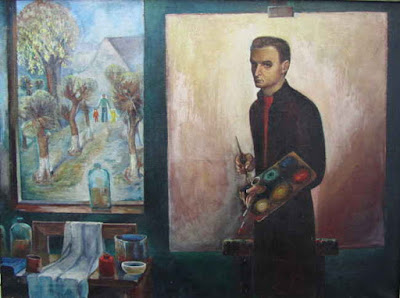 |
| Image: Steven Hermans |
Theodor (Tjodor) Herzen was a bookkeeper of German descent who, living in the little village of Orlovka, taught himself to paint.
The Talas valley had been home to many Germans at the time, who settled here in numbers in the late 19th century, and Orlovka was populated by Germans since 1882.
The Herzens were late arrivals, forcibly resettled by the Kremlin in the 1920’s, together with other Germans and different Caucasian peoples.
Old man Herzen was not particularly talented, but he gave birth to a son, also called Theodor Herzen. He became one of the great artists of Kyrgyzstan, and his work can still be found all over the country, in mosaics, bas-reliefs, paintings and graphic work.
The museum consists of a large, 2-floor space. Downstairs, one room is dedicated to the work of father and son Herzen, mostly centered around Orlovka. There are a few large landscape tableaus, and portraits of village people give a sense of how life in an ethnically mixed community must have been in those days (there are no Germans left in Orlovka). Youthful work of the son shows he had great talent and flair from an early age.
 |
| Image: Steven Hermans |
The paintings show the array of styles popular/allowed during the 40’s, 50’s and 60’s, when many Soviet artists came to Orlovka. There are also some sculptures, including one by Vera Mukhina.
Downstairs again, and in a room which mixes pots and irrigation pipes from the ancient Silk Road settlement of Ak Dobo with ceramics from museum caretaker Almaz, hang some of Herzen’s best works. As a child he would listen to Kyrgyz bards as they told the ancient tale of Manas, and during 8 years in the 1970’s he worked on a graphic version of the story. Some of the litho prints can be seen here, while many more illustrate the Manas book.
Rounding off, you get to see some Soviet keepsakes, pins of the places in the Soviet Union Herzen visited, and check out the Lenin head in the office. The unlikely location of the museum and the expert commentary from Almaz (Russian/Kyrgyz only) make for an interesting stop on your way to/from Talas.
A taxi there costs 50 som from dowtown. Entrance to the museum is by donation. The museum is closed and only opened on request. Caretaker Almaz can be reached at +996 701 602 345, or ask Turdubek from CBT (Community Based Tourism) in Talas.
 |
| Herzen's illustration for the epic Manas |
Next to the museum, the House of Culture is another interesting Soviet sight, with a sad Ferris wheel in the background, and a golden fountain in front, rather intriguingly renovated by a bunch of Swiss people in 2010. From Orlovka, you can hike to Besh Tash via Urmaral valley and Besh Kol.
Note: The Herzen museum is not visited during the Uzbek Journeys tour. However, if you have extra time in Kyrgyzstan, an excursion there can be arranged. Talas is 300 kms from Bishkek.
This article, written by Steven Hermans, was originally published on Caravanistan and later on Minor Sights. It is published here with permission.
Related posts:
Tashkent Nostalgie - Eugene Panov's Exhibition, Tashkent
Central Asia in Art: From Soviet Orientalism to the New Republics
Homage to Savitsky
Ernst Neizvestny's Last Soviet Sculpture - Ashgabat, Turkmenistan